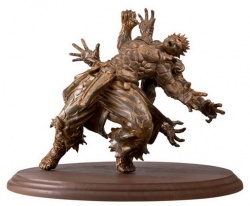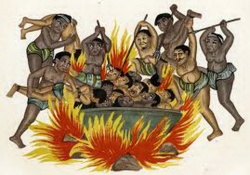Hell or Naraka
Swami Sivananda, “Hells are not imaginary fiction as ordinarily conceived of by the modern rationalistic mind….Hells, therefore, are as much real worlds as the regions of Indra or this mortal earth of ours. They are regions with difference only in the subtlety of the plane of their manifestation. They differ in the degree of the state of Consciousness revealed through them. The sufferings inflicted on the sinners may be taken to mean either an actual birth in such regions, or a life on earth with such entanglements, where one will undergo such pains either directly or through the agency of others. “ .
According to Sanatana Dharma, Naraka is a place where souls are sent for the expiation of their sins. There is just not one naraka, but several. To be specific, there are seven. In these seven, there are 29 regions of suffering (pg. 26, Karma & Diseases). Often, when references are made to “hell”, it is always in the plural, viz., “hells”, “hellish planets”, etc. They are called by several names: Raurava, Maharaurava, Vahni, Vaitarani and Kumbhika. These abodes are meant for short stay. The places where souls dwell longer to suffer are Tamisra (darkness) and Andhatamisra (blinding darkness).
Tamisra Those people who lay hands on another’s wealth, children and wives are born in Tamisra region. The Jiva experiences there extreme pain being bound with mortal cords and violently hurled into the dark regions. He has no food or drink. He is beaten with clubs, and by holding out threats and being brought to a state of weary affliction, the Jiva drops down in a swoon.
Andhatamisra In Andhatamisra, Jivas are born who deceive husbands and appropriate to them selves their wives and other property. Such Jivas are cast down into this hell to suffer torments where they lose all understanding and sense through excessive pain. The Jiva suffers like a tree whose roots are cut.
Raurava Those who grossly identify themselves with this physical body and regard the wealth of the world as their own, fall into a hell called Raurava. Those people who torment people here on earth become subject to the torment of poisonous worms called Rurus in this dangerous region.
Maharaurava Maharaurava is of the same type. Those men who indulge in passions are eaten here by carnivorous (flesh-eating) animals.
Kumbhipaka In the hell called Kumbhipaka, dreadful fiends begin to boil in oil that cruel and merciless person who cooks and eats living animals, birds and the like.
The seven hells are superintended by Chitragupta and others. Yama is the chief ruler in those seven hells also. Chitragupta and others are only superintendents and lieutenants employed by Yama. They are all under Yama’s government and suzerainty. Chitragupta and others are directed by Yama.
For those of us who are familiar with Srimad Bhagavad Gita’s pronouncement about the soul: “Weapons cut It not, fire burns It not, water wets It not, wind dries It not” (2:23), may find this notion of the perfect soul that is not affected by anything not congenital or innate to its nature a little contradictory. However, if you read Gita 4:14 (“….He who knows Me thus is not bound by actions.”), you will know what the first sentence means.
This idea of expiation in hells is mentioned especially in our Vedas, Itihaasa and Puranas and even in the Samhitas Aranyakas and Upanisads. In Iso Upanisad, for instance, speaks of ‘darkness’ instead of hell. Srimad Bhagavatam, Garuda Purana and Visnu Purana have elaborate descriptions of many hells. They are situated above Garbhodaka ocean. {Bhagavatam 5:26:5)
Yama Dharama Raja, the Lord of Justice, puts living beings after death for appropriate punishment, for example, in boiling oil. According to Madhvacharya, the propounder of the Dawitin philosophy, even Mukti-yogyas (=souls that are eligible for mukti or moksha or liberation) can experience naraka. The evidence of which can be found in Mahabarath, for instance: Yudisthira maharaj, who was in every way a fit candidate for moksha, went to naraka (hell), but momentarily, to atone for a sin he committed on the battle field.
After the period of punishment is complete, souls that entered the hell are reborn on earth in human or animal bodies. Therefore neither naraka nor swarga are permanent abodes.
Naraka, which is often referred to as Yama Loka is not equivalent of the Christian or Muslim Hell. Unlike most other religions, especially Abrahamic religions, according to Sanatana Dharma hell is a temporary purgatorium for sinners or papis: Yama’s divine assistant Lord Chitragupta maintains a record of the individual deeds of every living being in the world, and based on the complete audit of his deeds, dispatches the soul either to swarga or to the various Narakas according to the nature of their sins.
In this regard, as explained above, no one, not even people who are fit for moksha and people, who have done a majority of good deeds, could come to naraka (akaYama Loka) for redemption from the small sins that they have committed—after they have suffered for their sins, they would incarnate in any form or be sent to heaven, depending on their karma.
At the time of death, Yamadutas (sometime referred to as “Yama Pinggalas“) come to take away sinful souls. Swami Haridoss, quoting the scriptures, has said Yama personally comes only for virtuous souls.
“There are two kinds of souls, viz., the individual soul or Jivatman or the human soul, and the Supreme Soul or Paramatman. The individual soul is an image or reflection of the Supreme Soul. Just as the Sun is reflected in different pots of water, so also the Supreme Soul is reflected in different minds of different persons.
“Soul is spirit. It is immaterial. It is intelligence or consciousness. It is Chaitanya. Individual soul is reflected Chaitanya. It is this individual soul that departs from the body after its death and goes to heaven, with the senses, mind, Prana, impressions, desires and tendencies. It is endowed with a subtle astral body when it proceeds to heaven.
“When the water in the lake is absorbed, the reflection of, the Sun in the water merges in the Sun itself. Even so, when the mind is annihilated through meditation, the individual soul merges itself in the Supreme Soul or Paramatman. This is the goal of life.
“The individual soul has become impure through cravings, desires, egoism, pride, greed, lust and likes and dislikes. Hence it is finite (Paricchinna), it is endowed with limited knowledge (Alpajna) and limited power (Alpa-Saktiman). The Supreme Soul is Infinite, Omniscient and Omnipotent. It is an embodiment of knowledge and bliss.
“The individual soul is under bondage through ignorance and limiting adjuncts such as mind, body and senses. It is mere appearance. It is illusory. When it attains knowledge of the Imperishable, it is freed from limiting adjuncts and bondage. Just as the bubble becomes one with the ocean, so also the Jiva becomes one with the Supreme Soul when ignorance is destroyed.”

